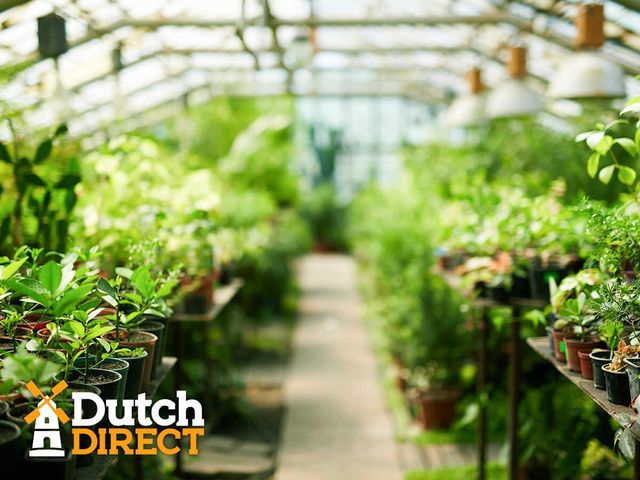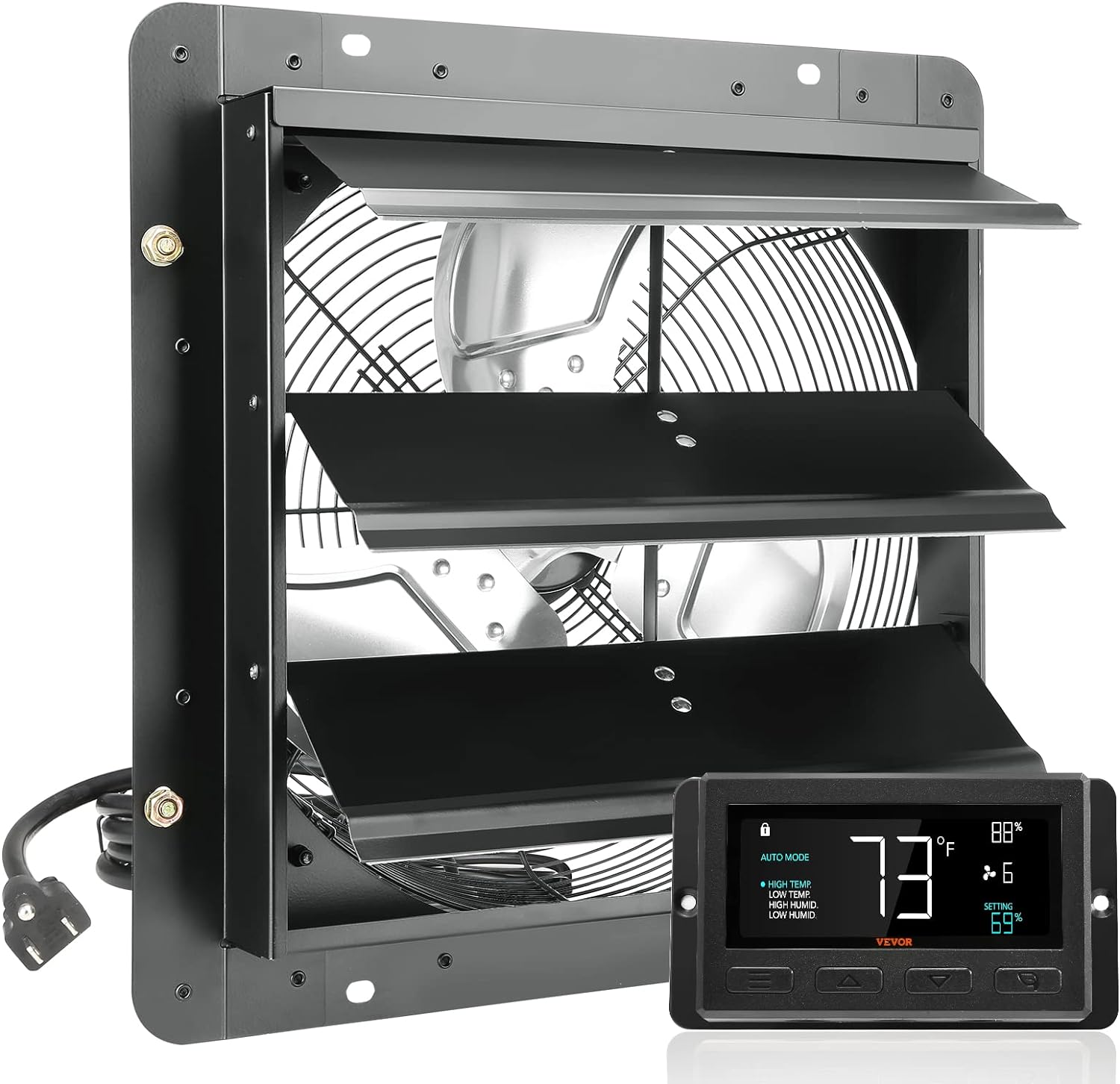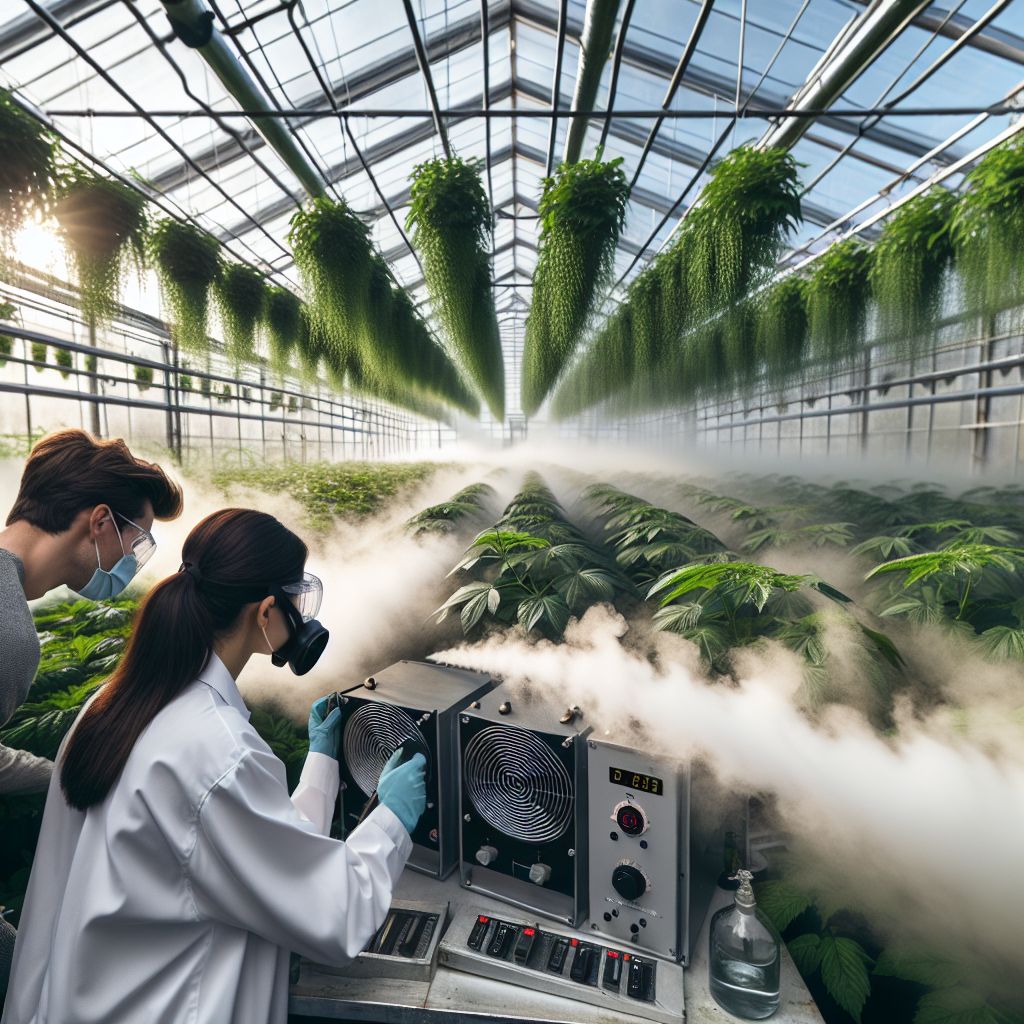Key Takeaways
-
Air movement is essential for maintaining a uniform climate in greenhouses, which directly impacts plant health and yield.
-
Horizontal Air Flow (HAF) fans are effective for even temperature distribution across the greenhouse.
-
Proper placement and sizing of fans can significantly improve air circulation and reduce energy costs.
-
Combining mechanical ventilation with natural ventilation can optimize air quality and reduce disease risk.
-
Using sensors and automation can help maintain optimal humidity and temperature levels, enhancing overall crop performance.
Air Movement Optimization Tips & Best Practices for Greenhouse Farming
Creating the perfect environment inside a greenhouse is crucial for the health and productivity of plants. One of the most important factors in achieving this is air movement. Proper air circulation ensures a uniform climate, which helps plants grow stronger and healthier. Let’s dive into some essential tips and best practices for optimizing air movement in your greenhouse.
Why Air Movement is Crucial in Greenhouse Farming
Air movement plays a pivotal role in greenhouse farming. It helps maintain a consistent temperature and humidity level throughout the space. This uniformity is vital because plants thrive in stable conditions. Without adequate air movement, hot and cold spots can develop, leading to uneven plant growth and increased risk of disease.
For instance, stagnant air can cause moisture to build up on plant surfaces, creating a breeding ground for mold and mildew. By ensuring proper air circulation, you can prevent these issues and promote a healthier growing environment.
How Air Movement Affects Plant Health and Yield
Good air movement has a direct impact on plant health and yield. When air circulates properly, it helps to:
-
Distribute heat evenly, preventing hot spots that can stress plants.
-
Reduce humidity levels, lowering the risk of fungal diseases.
-
Enhance CO2 distribution, which is essential for photosynthesis.
-
Improve transpiration, allowing plants to absorb nutrients more efficiently.
For example, a greenhouse with poor air circulation might see a higher incidence of powdery mildew due to trapped moisture around the plants. Conversely, a greenhouse with optimized air movement will have healthier plants with better yields.

“Why Is Air Circulation So Important In …” from www.dutchdirect.us
Benefits of Optimizing Air Movement
Optimizing air movement in your greenhouse offers several benefits:
-
Increased Crop Yields: Consistent air circulation promotes uniform growth, leading to higher overall yields.
-
Reduced Disease Risk: Proper air movement helps prevent the buildup of moisture, reducing the risk of fungal and bacterial diseases.
-
Energy Efficiency: By maintaining a stable climate, you can reduce the need for additional heating or cooling, saving on energy costs.
-
Enhanced Plant Quality: Plants grown in a well-ventilated environment are generally healthier, stronger, and of better quality.
In essence, by focusing on air movement, you create a more efficient and productive greenhouse environment. This translates to better plant health, higher yields, and ultimately, greater profitability for your farming operation.
Choosing the Right Equipment for Air Movement
To optimize air movement in your greenhouse, selecting the right equipment is crucial. Different types of fans and ventilation systems can be used, each with its own set of advantages. Let’s explore some of the options available, including smart greenhouse systems.
Types of Fans: HAF, Exhaust, and Circulation Fans
There are several types of fans that can be used to improve air circulation in a greenhouse:
-
Horizontal Air Flow (HAF) Fans: These fans are designed to create a horizontal airflow pattern, promoting even temperature distribution throughout the greenhouse. They are typically mounted above the crop level and are ideal for larger greenhouses.
-
Exhaust Fans: These fans are used to remove hot air from the greenhouse, especially during the summer months. They help to maintain a cooler environment and can be used in conjunction with intake vents for optimal ventilation.
-
Circulation Fans: These fans help to keep air moving within the greenhouse, preventing stagnant air pockets. They can be placed at various heights and locations to ensure comprehensive air movement.
 |
 |
 |
|
Horizontal Air Flow (HAF) Fans |
Exhaust Fans |
Circulation Fans |
Choosing the right type of fan depends on the specific needs of your greenhouse and the crops you are growing. Each type of fan has its own benefits, so consider your requirements carefully before making a decision.
Proper Sizing and Placement of Fans
Once you’ve selected the appropriate type of fan, it’s essential to ensure they are correctly sized and placed for maximum effectiveness. Here are some tips for proper fan placement:
-
Calculate Air Volume: Determine the total volume of air in your greenhouse. This will help you choose fans with the right capacity to move the required amount of air.
-
Even Distribution: Place fans evenly throughout the greenhouse to ensure consistent air movement. Avoid clustering fans in one area, as this can lead to uneven airflow.
-
Height Considerations: Mount fans at different heights to promote vertical air circulation. This helps to eliminate temperature stratification and ensures a uniform climate.
-
Regular Maintenance: Keep fans clean and well-maintained to ensure they operate efficiently. Regularly check for any obstructions that could impede airflow.
Proper fan placement and sizing can significantly improve air circulation, leading to a healthier and more productive greenhouse environment.
Cost vs. Efficiency of Different Air Movement Solutions
When choosing air movement solutions, it’s important to consider both cost and efficiency. While some options may have a higher upfront cost, they can offer greater long-term benefits in terms of energy savings and improved crop yields.
For example, investing in high-quality HAF fans may require a larger initial investment, but their ability to maintain a uniform climate can lead to better plant health and higher yields. On the other hand, using less expensive exhaust fans may be more affordable initially, but they may not provide the same level of climate control.
Here’s a comparison table to help you weigh the costs and benefits of different air movement solutions. For additional insights on optimizing your greenhouse, check out our guide on smart greenhouse systems.
|
Solution |
Initial Cost |
Energy Efficiency |
Climate Control |
Maintenance |
|---|---|---|---|---|
|
HAF Fans |
High |
Very Efficient |
Excellent |
Low |
|
Exhaust Fans |
Moderate |
Moderate |
Good |
Moderate |
|
Circulation Fans |
Low |
Efficient |
Fair |
Low |
Consider your budget and long-term goals when selecting air movement solutions. Investing in high-quality equipment can pay off in the long run through improved plant health and increased yields.
Proper fan placement and sizing can significantly improve air circulation, leading to a healthier and more productive greenhouse environment.
Proper Sizing and Placement of Fans
Once you’ve selected the appropriate type of fan, it’s essential to ensure they are correctly sized and placed for maximum effectiveness. Here are some tips for proper fan placement, as discussed in this guide on creating the optimal greenhouse environment:
-
Calculate Air Volume: Determine the total volume of air in your greenhouse. This will help you choose fans with the right capacity to move the required amount of air.
-
Even Distribution: Place fans evenly throughout the greenhouse to ensure consistent air movement. Avoid clustering fans in one area, as this can lead to uneven airflow.
-
Height Considerations: Mount fans at different heights to promote vertical air circulation. This helps to eliminate temperature stratification and ensures a uniform climate.
-
Regular Maintenance: Keep fans clean and well-maintained to ensure they operate efficiently. Regularly check for any obstructions that could impede airflow.
Effective Air Movement Techniques
To maximize the benefits of air movement, it’s important to use the right techniques. These methods will ensure that air circulates effectively throughout your greenhouse, creating the ideal environment for your plants.
Horizontal Air Flow (HAF) for Even Temperature Distribution
Horizontal Air Flow (HAF) fans are designed to create a horizontal airflow pattern, which helps to distribute temperature evenly across the greenhouse. These fans are typically mounted above the crop level and work by moving air in a circular pattern. This circulation helps to eliminate hot and cold spots, ensuring a consistent climate for all plants.
To set up HAF fans effectively, you may also want to explore smart greenhouse systems for optimal environmental control.
-
Mount fans at regular intervals throughout the greenhouse.
-
Ensure that the fans are positioned to create a circular airflow pattern.
-
Adjust fan speed to maintain a gentle but consistent air movement.
By using HAF fans, you can create a more uniform climate, which is essential for healthy plant growth.
Natural Ventilation vs. Mechanical Ventilation
Ventilation is another critical aspect of air movement in greenhouses. There are two main types of ventilation: natural and mechanical. Each has its own advantages and disadvantages.
-
Natural Ventilation: This method relies on the natural movement of air through vents and openings in the greenhouse. It’s a cost-effective option that uses no electricity. However, it can be less reliable, especially in areas with little wind or during extreme weather conditions.
-
Mechanical Ventilation: This method uses fans and other mechanical devices to move air. It’s more reliable and can be controlled more precisely, but it requires an initial investment and ongoing energy costs.
Combining both natural and mechanical ventilation can provide the best results. For example, you can use natural ventilation during mild weather and switch to mechanical ventilation during extreme conditions. For more information, check out this guide on smart greenhouse systems.
Using Smoke Machines to Test Air Movement
One effective way to test air movement in your greenhouse is by using a smoke machine. This method allows you to visualize how air flows and identify any areas where circulation might be lacking. For more tips on optimizing your greenhouse environment, check out this guide on using air movement effectively.
Here’s how to use a smoke machine for testing: If you are setting up a greenhouse, you might also find our weather station setup guide helpful.
-
Place the smoke machine at various points in the greenhouse.
-
Observe the movement of the smoke to see how air is circulating.
-
Identify any stagnant areas where smoke lingers.
-
Adjust fan placement or add additional fans to improve airflow in those areas.
Using a smoke machine can help you fine-tune your air movement strategy, ensuring that every part of your greenhouse receives adequate circulation. For more advanced techniques, check out this guide on greenhouse gardening trends.

Maintaining Proper Humidity and Temperature Levels
Proper air movement is essential for maintaining optimal humidity and temperature levels in your greenhouse. Here are some tips to achieve this:
-
Monitor Conditions: Use sensors to keep track of temperature and humidity levels. This data will help you make informed decisions about ventilation and air movement.
-
Adjust Ventilation: Increase or decrease ventilation based on the current conditions. For example, open vents during hot weather to release excess heat and close them during cold weather to retain warmth.
-
Use Humidifiers or Dehumidifiers: Depending on your climate, you may need to add or remove moisture from the air. Humidifiers can help during dry conditions, while dehumidifiers are useful in high-humidity environments.
Maintaining the right humidity and temperature levels is crucial for preventing plant stress and promoting healthy growth.
Integrating Air Movement with Other Climate Controls
Optimizing air movement is just one part of creating the ideal greenhouse environment. Integrating it with other climate controls can further enhance your results.
Combining Airflow with Heating Systems
Heating systems are essential for maintaining a stable temperature in your greenhouse, especially during colder months. By combining these systems with proper air movement, you can ensure even heat distribution and prevent hot or cold spots.
For example, you can use HAF fans to circulate warm air from heating pipes or units, ensuring that all areas of the greenhouse receive consistent warmth. This combination helps to create a more uniform climate, reducing the risk of plant stress.
Optimizing Ventilation with Shading Techniques
Shading techniques can help control the amount of sunlight entering your greenhouse, preventing overheating during hot weather. By integrating shading with ventilation, you can create a more comfortable environment for your plants. For more tips, check out these greenhouse gardening trends.
For instance, you can use shade cloths or retractable screens to reduce sunlight during peak hours. Combined with proper ventilation, this can help maintain a cooler temperature and prevent heat stress.
Using Sensors and Automation for Climate Control
Modern technology offers advanced tools for optimizing greenhouse climate control. Sensors and automation systems can monitor conditions in real-time and make adjustments as needed.
Here are some benefits of using sensors and automation:
-
Real-Time Monitoring: Sensors provide up-to-date information on temperature, humidity, and CO2 levels.
-
Automated Adjustments: Automation systems can adjust fans, vents, and other equipment based on sensor data, ensuring optimal conditions at all times.
-
Energy Efficiency: By making precise adjustments, automation systems can reduce energy consumption and lower operating costs.
Integrating sensors and automation into your greenhouse can help you maintain the perfect environment for your plants, leading to better growth and higher yields.
Frequently Asked Questions (FAQ)
What is the best type of fan for air movement in greenhouses?
The best type of fan for air movement in greenhouses depends on your specific needs. HAF fans are excellent for creating even temperature distribution, while exhaust fans are ideal for removing hot air. Circulation fans are great for keeping air moving within the greenhouse. Consider your greenhouse size, crop type, and climate conditions when choosing the right fan.
How often should I test my greenhouse’s air movement?
It’s recommended to test your greenhouse’s air movement regularly, at least once a month. Use tools like smoke machines to visualize airflow and identify any stagnant areas. Regular testing ensures that your air movement system is functioning correctly and helps you make necessary adjustments to maintain optimal conditions.
What are the cost benefits of using fans over heating pipes?
Using fans can be more cost-effective than heating pipes in several ways. Fans generally have lower initial costs and are easier to install. They also consume less energy, leading to reduced operating costs. Additionally, fans help maintain a uniform climate, which can improve plant health and increase yields, providing long-term economic benefits.
How can I integrate air movement with other climate controls?
Integrating air movement with other climate controls involves combining fans with heating systems, ventilation, shading techniques, and automation. Use HAF fans to distribute heat evenly, and combine natural and mechanical ventilation to optimize air quality. Employ shading techniques to control sunlight and use sensors and automation for real-time adjustments. This comprehensive approach ensures a stable and productive greenhouse environment.
Air movement is a crucial factor in greenhouse farming, as it helps regulate temperature, humidity, and CO2 levels, ensuring optimal plant growth. Proper ventilation can prevent the buildup of excess heat and humidity, reducing the risk of diseases and pests. Additionally, effective air circulation can enhance pollination and improve the overall health of your plants. To learn more about optimizing your greenhouse environment, check out these 2024 greenhouse gardening trends that offer valuable insights and tips.
